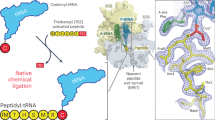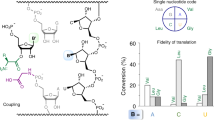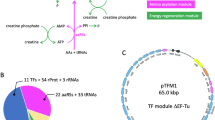Abstract
THE liver ribosomes of hypophysectomized rats are less able to incorporate amino-acids into protein in vitro than those of normal rat liver1. Ribosomal preparations from hypophysectomized rats contain less polysomes than those from normal rats2, and the rate of synthesis of messenger ribonucleic acid (mRNA) and other kinds of RNA is depressed2,3 after hypophysectomy. The action of growth hormone in promoting protein synthesis and growth can be explained in terms of its action in stimulating the synthesis of mRNA2,4, but this hypothesis does not explain all the facts. It has been noted4, for example, that the percentage stimulation of phenylalanine incorporation obtained by addition of 25 µg of polyuridylic acid (poly U) to the cell-free system with ribosomes from liver of hypophysectomized rats was as great as, or greater than, that obtained when ribosomes from liver of normal rats were used; but the absolute level of incorporation with ribosomes from hypophysectomized rats was still less than that obtained with normal rat liver ribosomes. The amount of poly U used was arbitrary and was probably not optimal for the system; thus it was decided to reinvestigate this point under conditions which were optimal for incorporation of phenylalanine into polypeptide in the presence of poly U.
This is a preview of subscription content, access via your institution
Access options
Subscribe to this journal
Receive 51 print issues and online access
$199.00 per year
only $3.90 per issue
Buy this article
- Purchase on Springer Link
- Instant access to full article PDF
Prices may be subject to local taxes which are calculated during checkout
Similar content being viewed by others
References
Korner, A., Biochem. J., 81, 292 (1961).
Korner, A., Biochem. J., 92, 449 (1964).
Talwar, G. P., Panda, N. C., Sarin, G. S., and Tolani, A. J., Biochem. J., 82, 173 (1962).
Korner, A., Rec. Prog. Hormone Res., 21, 205 (1965).
Munro, A. J., Jackson, R. J., and Korner, A., Biochem. J., 92, 289 (1964).
Korner, A., Acta Endocrinol., Supplement 100: 20 (1965).
Korner, A., J. Cell. and Comp. Physiol. (in the press).
Earl, D. C. N., and Korner, A., Biochim. Biophys. Acta (in the press).
Rampersad, O. R., and Wool, I. G., Fed. Proc., 24, 511 (1965). Science, 149, 1102 (1965).
Author information
Authors and Affiliations
Rights and permissions
About this article
Cite this article
KORNER, A., GUMBLEY, J. Impaired Ability of Ribosomes to react with Polyuridylic Acid after Hypophysectomy of the Rat : Removal of the Disability by a Cell Sap Factor. Nature 209, 505–506 (1966). https://doi.org/10.1038/209505a0
Issue Date:
DOI: https://doi.org/10.1038/209505a0
Comments
By submitting a comment you agree to abide by our Terms and Community Guidelines. If you find something abusive or that does not comply with our terms or guidelines please flag it as inappropriate.



